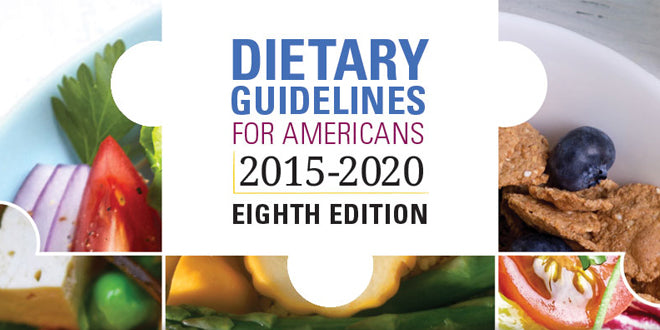Cardiovascular disease, type 2 diabetes and obesity have been on the rise, but an abundance of research shows that healthy eating patterns and regular physical exercise reduce the risk of chronic diseases and lead to longer lifespans. We also need essential supplements to provide sufficient living nutrition to promote cellular health needed for optimal health.
Under the 1990 National Nutrition Monitoring and Related Research Act, the U.S. Departments of Health and Human Services (HHS) and of Agriculture (USDA) must publish a report outlining nutritional and dietary information and guidelines for the general public. The jointly published report seeks to educate medical professionals and the general public on new nutritional research that can lead to a healthier, and longer living, populace.
Previous editions of the
USDA Dietary Guidelines focused specifically on individual dietary components like food groups and nutrients. In contrast, the
2015-2020 USDA Dietary Guidelines focus on an overall eating pattern that can be tailored to fit every person’s dietary needs. The current
Dietary Guidelines outline these overarching principles that encourage healthy eating patterns:
- Follow a healthy eating pattern across the lifespan
- Focus on variety, nutrient density and amount
- Limit calories from added sugars and saturated fats
- Reduce sodium intake,
- Shift to healthier food and beverage choices and support healthy eating patterns for all
For the first time ever, the USDA threw away its infamous “Food Pyramid,” and replaced it with “MyPlate.” MyPlate resembles a dinner plate that is divided into quadrants of various sizes. The vegetable quadrant is the largest, followed by whole grains, then fruits, and finally protein.
Way ahead of its time, the Hallelujah Diet has prided itself for two decades on offering the framework for optimal health in ways that the
Dietary Guidelines now show to be the true path to a healthy, disease-free body.
A Healthy Eating Pattern
Perhaps the biggest change in the
2015-2020 USDA Dietary Guidelines is the emphasis on a healthy eating pattern compared to the recommendation of specific foods and nutrients of past
Dietary Guidelines. A healthy eating pattern promotes a holistic approach to achieving optimal health that includes:
- The types of food that should be regularly consumed
- Those that should be avoided
- And a consistent commitment to following a healthy diet and receiving sufficient physical activity
The
Dietary Guidelines demonstrate the effectiveness of a plant-based diet by recommending that vegetables from all subgroups—dark green, red and orange and legumes—as well as fruits, nuts and seeds, soy products and whole grains should be consistently eaten. Additionally, saturated fats and trans fats—often found in animal products and processed grains—and added sugars and sodium should be rarely consumed.
With the publishing of its current
Dietary Guidelines, the USDA, like the Hallelujah Diet, is committing itself to providing Americans with the necessary resources to avoid disease and optimize health through a plant-based diet.
The Hallelujah Diet is the most effective and sustainable way to:
- Lose weight
- Age gracefully
- Boost your immune system
- Guard against disease
- Heighten your energy
- Maintain balanced blood sugar levels and
- Dramatically improve overall health and well-being.
HD is based entirely on:
- Eating raw, plant-based foods
- Flooding your cells with pure nutrition through juicing and whole food supplementation
- Resting plenty, stressing less and physically moving your body
The USDA scientifically proves that unhealthy eating patterns are associated with increased risk of type 2 diabetes, cancer, chronic disease and obesity, and the Hallelujah Diet is the ideal solution to educate about healthy eating patterns while providing products that are proven to optimize full-body health.
How Should You Get Your Protein?
Although it’s the smallest of the four quadrants on MyPlate, protein plays an important role in a healthy eating pattern. Specifically, the
Dietary Guidelines explain that protein is packed with nutrients like
vitamin B12,
vitamin B6, riboflavin,
selenium, choline,
phosphorus, zinc, copper,
vitamin D, and
vitamin E.
Additionally, the USDA confirms what HD has always said: plant-based protein is loaded with the same nutrients as animal protein. While the
Dietary Guidelines highlight the immense protein in nuts, seed, soy products and legumes, the USDA highlights animal protein’s positives without explaining the disease-causing aspects of an animal-based diet, which some nutritional scholars have called irresponsible.
Kathie Swift, MS, RD, who is Nutrition Director for Food as Medicine at the Center for Mind-Body Medicine in Washington, is especially against the USDA’s animal product recommendation saying, “We have a pandemic of allergies, asthma, IBS and many other conditions that are linked to dairy consumption.” She continues, “Cow’s milk is not an essential component of the diet for humans, so why display it as a nutritional icon?”
Understanding that protein is a vital part of optimal health and that animal protein has numerous damaging, disease causing properties, reach for
Hallelujah Diet’s Essential Protein Pure Powder to fulfill all your protein needs in an efficient, delicious supplement. Aside from its high level of protein, HD Essential Protein Pure Powder is 100% organic, full of vitamins and minerals and loaded with prebiotic fibers that increase immune system and gastrointestinal function.
Avoid Sugar & Saturated Fat
Virtually every nutritionist would agree with the
Dietary Guidelines that reducing intake of added sugar is a necessary step towards optimal health. The USDA points specifically to high-added sugar beverages, like unnatural fruit juices and soft drinks, as a major cause of Americans’ elevated sugar levels. David Katz, MD, Director of the Yale University Prevention Research Center says, “…we’ve lost sight of the fact that excess sugar drives up insulin levels and increases inflammation.”
The
Dietary Guidelines recommend that Americans consume less than 10% of their daily calories from saturated fats. Saturated fats are especially dangerous to the body because the human body has no dietary need for the damaging fats. Evidence shows that saturated fats increase total cholesterol and LDL cholesterol, which can lead to heart attacks and cardiovascular disease.
Instead of high saturated fat foods like animal products and processed foods, the USDA recommends foods with sources of monounsaturated fats like olive oil and nuts to reduce total cholesterol and LDL cholesterol, increase HDL cholesterol and diminish the risk of cardiovascular heart disease.
Takeaways
- The 2015-2020 USDA Dietary Guidelines are a major improvement upon its previous editions because the USDA now primarily promotes a plant-based diet.
- But it misses the mark slightly by recommending animal products like animal protein and dairy products.
- Also, added sugars and food high in sodium should be avoided at all costs due to their likelihood to increase blood pressure, insulin levels and inflammation.
Finally, the key to achieving optimal health is a dedicated commitment to healthy eating patterns that are packed with nutrient-dense, plant-based foods like whole grains, nuts, seeds, fruits and vegetables.








